Core Strengthening Exercises
Medically reviewed by Drugs.com. Last updated on Aug 4, 2025.
What do I need to know about core strengthening exercises?
Your core includes the muscles of your lower back, hip, pelvis, and abdomen. Core strengthening exercises help heal and strengthen these muscles. This helps prevent another injury, and keeps your pelvis, spine, and hips in the correct position.
What do I need to know about exercise safety?
Talk to your healthcare provider before you start an exercise program. A physical therapist can teach you how to do core strengthening exercises safely.
- Do the exercises on a mat or firm surface. A firm surface will support your spine and prevent low back pain. Do not do these exercises on a bed.
- Move slowly and smoothly. Avoid fast or jerky motions.
- Stop if you feel pain. You may feel some discomfort at first, but you should not feel pain. Tell your provider or physical therapist if you have pain while you exercise. Regular exercise will help decrease your discomfort over time.
- Breathe normally during core exercises. Do not hold your breath. This may cause an increase in blood pressure and prevent muscle strengthening. Your healthcare provider will tell you when to inhale and exhale during the exercise.
- Begin all of your exercises with abdominal bracing. Abdominal bracing helps warm up your core muscles. You can also practice abdominal bracing throughout the day. Lie on your back with your knees bent and feet flat on the floor. Place your arms in a relaxed position beside your body. Tighten your abdominal muscles. Pull your belly button in and up toward your spine. Hold for 5 seconds. Relax your muscles. Repeat 10 times.
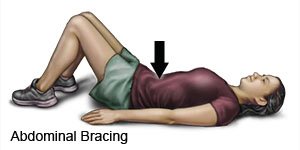
How do I perform core strengthening exercises?
Your healthcare provider will tell you how often to do these exercises. The provider will also tell you how many repetitions of each exercise you should do. Hold each exercise for 5 seconds or as directed. As you get stronger, increase your hold to 10 to 15 seconds. You can do some of these exercises on a stability ball, or with a weight. Ask your healthcare provider how to use a stability ball or weight for these exercises:
- Bridging: Lie on your back with your knees bent and feet flat on the floor. Rest your arms at your side. Tighten your buttocks, and then lift your hips 1 inch off the floor. Hold for 5 seconds. When you can do this exercise without pain for 10 seconds, increase the distance you lift your hips. A good goal is to be able to lift your hips so that your shoulders, hips, and knees are in a straight line.
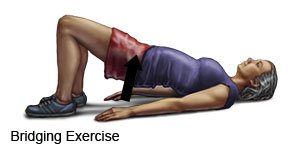
- Dead bug: Lie on your back with your knees bent and feet flat on the floor. Place your arms in a relaxed position beside your body. Begin with abdominal bracing. Next, raise one leg, keeping your knee bent. Hold for 5 seconds. Repeat with the other leg. When you can do this exercise without pain for 10 to 15 seconds, you may raise one straight leg and hold. Repeat with the other leg.
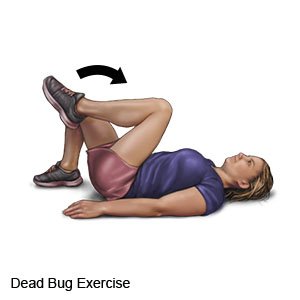
- Quadruped: Place your hands and knees on the floor. Keep your wrists directly below your shoulders and your knees directly below your hips. Pull your belly button in toward your spine. Do not flatten or arch your back. Tighten your abdominal muscles below your belly button. Hold for 5 seconds. When you can do this exercise without pain for 10 to 15 seconds, you may extend one arm and hold. Repeat on the other side.
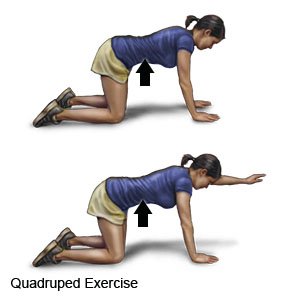
- Side bridge exercises:
- Standing side bridge: Stand next to a wall and extend one arm toward the wall. Place your palm flat on the wall with your fingers pointing upward. Begin with abdominal bracing. Next, without moving your feet, slowly bend your arm to 90 degrees. Hold for 5 seconds. Repeat on the other side. When you can do this exercise without pain for 10 to 15 seconds, you may do the bent leg side bridge on the floor.
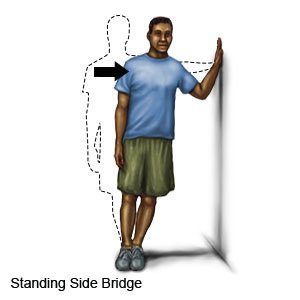
- Bent leg side bridge: Lie on one side with your legs, hips, and shoulders in a straight line. Prop yourself up onto your forearm so your elbow is directly below your shoulder. Bend your knees back to 90 degrees. Begin with abdominal bracing. Next, lift your hips and balance yourself on your forearm and knees. Hold for 5 seconds. Repeat on the other side. When you can do this exercise without pain for 10 to 15 seconds, you may do the straight leg side bridge on the floor.
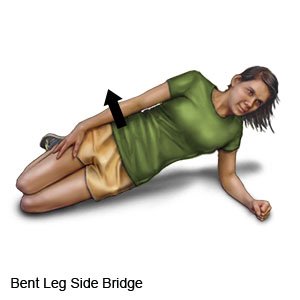
- Straight leg side bridge: Lie on one side with your legs, hips, and shoulders in a straight line. Prop yourself up onto your forearm so your elbow is directly below your shoulder. Begin with abdominal bracing. Lift your hips off the floor and balance yourself on your forearm and the outside of your flexed foot. Do not let your ankle bend sideways. Hold for 5 seconds. Repeat on the other side. When you can do this exercise without pain for 10 to 15 seconds, ask your healthcare provider for more advanced exercises.
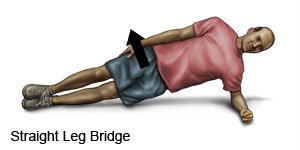
- Standing side bridge: Stand next to a wall and extend one arm toward the wall. Place your palm flat on the wall with your fingers pointing upward. Begin with abdominal bracing. Next, without moving your feet, slowly bend your arm to 90 degrees. Hold for 5 seconds. Repeat on the other side. When you can do this exercise without pain for 10 to 15 seconds, you may do the bent leg side bridge on the floor.
- Superman: Lie on your stomach. Extend your arms forward on the floor. Tighten your abdominal muscles and lift your right hand and left leg off the floor. Hold this position. Slowly return to the starting position. Tighten your abdominal muscles and lift your left hand and right leg off the floor. Hold this position. Slowly return to the starting position.
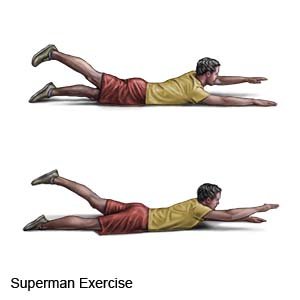
- Clam: Lie on your side with your knees bent. Put your bottom arm under your head to keep your neck in line. Put your top hand on your hip to keep your pelvis from moving. Put your heels together, and keep them together during this exercise. Slowly raise your top knee toward the ceiling. Then lower your leg so your knees are together. Repeat this exercise 10 times. Then switch sides and do the exercise 10 times with the other leg.
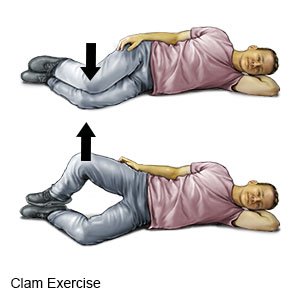
- Curl up: Lie on your back with your knees bent and feet flat on the floor. Place your hands, palms down, underneath your lower back. Next, with your elbows on the floor, lift your shoulders and chest 2 to 3 inches off the floor. Keep your head in line with your shoulders. Hold this position. Slowly return to the starting position.
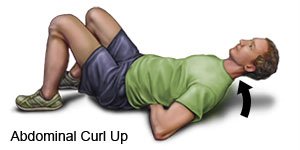
- Straight leg raises: Lie on your back with one leg straight. Bend the other knee and place your foot flat on the floor. Tighten your abdominal muscles. Keep your leg straight and slowly lift it straight up 6 to 12 inches off the floor. Hold this position. Lower your leg slowly. Do as many repetitions as directed on this side. Repeat with the other leg.
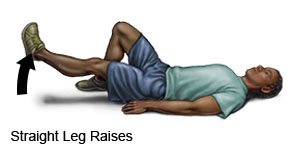
- Plank: Lie on your stomach. Bend your elbows and place your forearms flat on the floor. Lift your chest, stomach, and knees off the floor. Make sure your elbows are below your shoulders. Your body should be in a straight line. Do not let your hips or lower back sink to the ground. Squeeze your abdominal muscles together and hold for 15 seconds. To make this exercise harder, hold for 30 seconds or lift 1 leg at a time.
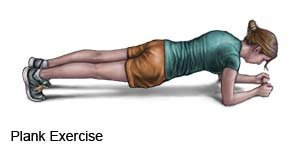
- Bicycles: Lie on your back. Bend both knees and bring them toward your chest. Your calves should be parallel to the floor. Place the palms of your hands on the back of your head. Straighten your right leg and keep it lifted 2 inches off the floor. Raise your head and shoulders off the floor and twist towards your left. Keep your head and shoulders lifted. Bend your right knee while you straighten your left leg. Keep your left leg 2 inches off the floor. Twist your head and chest towards the left leg. Continue to straighten 1 leg at a time and twist.
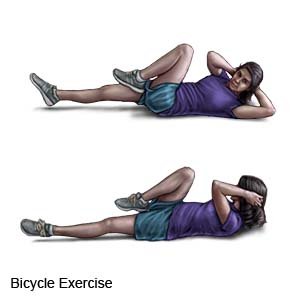
When should I call my doctor or physical therapist?
- You have sharp or worsening pain during exercise or at rest.
- You have questions or concerns about your condition, care, or exercise program.
Care Agreement
You have the right to help plan your care. Learn about your health condition and how it may be treated. Discuss treatment options with your healthcare providers to decide what care you want to receive. You always have the right to refuse treatment. The above information is an educational aid only. It is not intended as medical advice for individual conditions or treatments. Talk to your doctor, nurse or pharmacist before following any medical regimen to see if it is safe and effective for you.© Copyright Merative 2025 Information is for End User's use only and may not be sold, redistributed or otherwise used for commercial purposes.
Further information
Always consult your healthcare provider to ensure the information displayed on this page applies to your personal circumstances.
